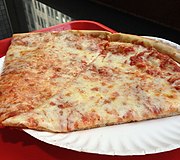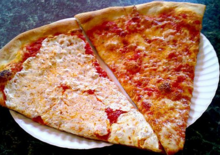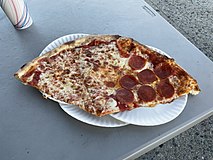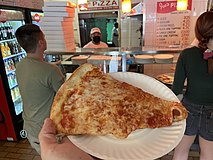New York–style pizza
| Type | Pizza |
|---|---|
| Place of origin | United States |
| Region or state | New York City, New York |
| Main ingredients | Pizza dough, tomato sauce, mozzarella |
New York–style pizza is a pizza made with a characteristically large hand-tossed thin crust, often sold in wide slices to go. The crust is thick and crisp only along its edge, yet soft, thin, and pliable enough beneath its toppings to be folded to eat.[1] Traditional toppings are simply tomato sauce and shredded mozzarella cheese. This was a popular meal among poor Italians due to the ratio of product from the limited produce.[2]
This style evolved in the U.S. from the pizza that originated in New York City in the early 1900s, itself derived from the Neapolitan-style pizza made in Italy.[2] Today, it is the dominant style eaten in the New York metropolitan area states of New York and New Jersey and is popular throughout the United States. Regional variations exist throughout the Northeast and elsewhere in the U.S.
History

The first pizzeria in the United States, Lombardi's, is said to have been founded by Gennaro Lombardi in New York City's Little Italy in 1905, though this has been challenged by author Peter Regas.[3] An immigrant pizzaiolo (pizza maker) from Naples, he opened a grocery store in 1897; eight years later, it was licensed to sell pizza by New York State.[4] An employee, Antonio Totonno Pero, began making pizza, which sold for five cents per pizza. Many people, however, could not afford a whole pizza and instead would offer what they could in return for a corresponding sized slice,[5] which was wrapped in paper tied with string. In 1924, Totonno left Lombardi's to open his own pizzeria on Coney Island, called Totonno's. Totonno's, Patsy's Pizzeria and John's Pizzeria are largely responsible for a renaissance and the growth of pizzerias such as Grimaldi's.[6]
The original pizzerias in New York used coal-fired ovens and baked their pizza with the cheese on the bottom and sauce on top.[citation needed] By 2010, over 400 pizza restaurants existed in New York City, with hundreds more of varied cuisine also offering the dish.[1]
Characteristics

New York–style pizza is traditionally hand-tossed,[7] consisting in its basic form of a light layer of tomato sauce[4] sprinkled with dry, grated, full-fat mozzarella cheese; additional toppings are placed over the cheese.[7] Pizzas are typically around 18 to 24 inches (45 to 60 cm) in diameter, and commonly cut into eight slices. These large wide slices[8] are often eaten as fast food while folded in half along the crust both for convenience—allowing the slice to be eaten one-handed—and to control the flow of oil running off the pizza. Folding pizza for fast food is seen in the beginning of Saturday Night Fever, when John Travolta, as Tony Manero, orders two slices at Lenny's Pizza in Bensonhurst Brooklyn and eats them placed on top of each other and folded while strutting down 86th Street.[9][10]
New York–style pizza gets its distinguishing crust from the high-gluten bread flour with which it is made. Minerals present in New York City's tap water supply are also credited with giving the dough in metro area pizzas its characteristic texture and flavor.[8][11] Some out-of-state pizza bakers even transport the water cross-country for the sake of authenticity.[12][13] However, many dispute this, claiming a similarly high-quality pizza can be made elsewhere with otherwise similar techniques and ingredients.[citation needed]
Typical condiments include dried oregano, dried red chili pepper flakes, garlic powder, dried basil, and grated Parmesan cheese.
Gallery
-
Characteristically large New York–style pizza ready to go into the oven
-
New York–style plain cheese pizza by the slice
-
Slices of traditional New York–style pizza on right, with fresh instead of dried mozzarella cheese on left
-
Three New York–style slices from New Park Pizza
-
A New York–style slice from Joe's Pizza
Regional variations
New York–style pizza is most prevalent in New York, New Jersey, Pennsylvania, Maryland, Delaware, District of Columbia, and Connecticut, but can be found throughout the Northeastern region and beyond.[7] Outside this area, many pizzas described as "New York–style",[1] including those of major pizza chains such as Pizza Hut, generally do not fall within the variations commonly accepted as genuine in its native area.
See also
- Pizza in the United States
- Pan pizza
- Jumbo slice – very large slice of pizza
- Pizza Principle – comparison between the cost of a slice of pizza and a subway ride in New York City
References
- ^ a b c Jackson, Kenneth T.; Keller, Lisa; Flood, Nancy (2010). The Encyclopedia of New York City (2nd ed.). New Haven: Yale University Press. pp. (unlisted). ISBN 978-0300182576.
- ^ a b Lev-Tov, Devorah (October 3, 2017). "What is New York Style Pizza?". Thespruceeats.com. Retrieved December 13, 2018.
- ^ "Special Sauce: Uncovering Pizza's US Origins". Archived from the original on March 28, 2019. Retrieved March 28, 2019.
- ^ a b Otis, Ginger Adams (2010). New York City 7. Lonely Planet. p. 256. ISBN 978-1741795912. Retrieved November 1, 2012.
- ^ Swerdloff, Alex (March 14, 2016). "What the Price of a Slice of Pizza Can Tell You About New York". Munchies.vice.com. Retrieved January 8, 2019.
- ^ Asimov, Eric (June 10, 1998). "New York Pizza, the Real Thing, Makes a Comeback". The New York Times.
- ^ a b c MacKenzie, Shea (1995). The Pizza Gourmet: Simple Recipes for Spectacular Pizza. Penguin. p. 81. ISBN 089529656X. Retrieved November 1, 2012.
- ^ a b Downing, Johnette; Kadair, Deborah Ousley (2011). Today Is Monday in New York. Pelican Publishing. pp. (unlisted). ISBN 978-1589808867. Retrieved November 1, 2012.
- ^ ISDA Staff (February 26, 2023). "Lenny's Pizza, Made Famous in 'Saturday Night Fever,' Closes After 70 Years in Business". Italian Sons and Daughters of America. Archived from the original on June 6, 2023. Retrieved March 19, 2024.
- ^ D., Paula (March 2, 2017). "The Double-Folded Slice - Travolta Style". The Glorified Tomato. Archived from the original on December 6, 2023. Retrieved March 19, 2024.
- ^ Gilbert, Sara (September 26, 2005). "New York Pizza: is the water the secret?". Slashfood. Weblogs, Inc. Archived from the original on September 5, 2010.
- ^ Cornwell, Rupert (July 21, 2006). "New York's 'Champagne Tap Water' Under Threat". The Independent. UK.
- ^ Wayne, Gary. "Mulberry Street Pizzeria". Seeing Stars in Hollywood. 2008.



